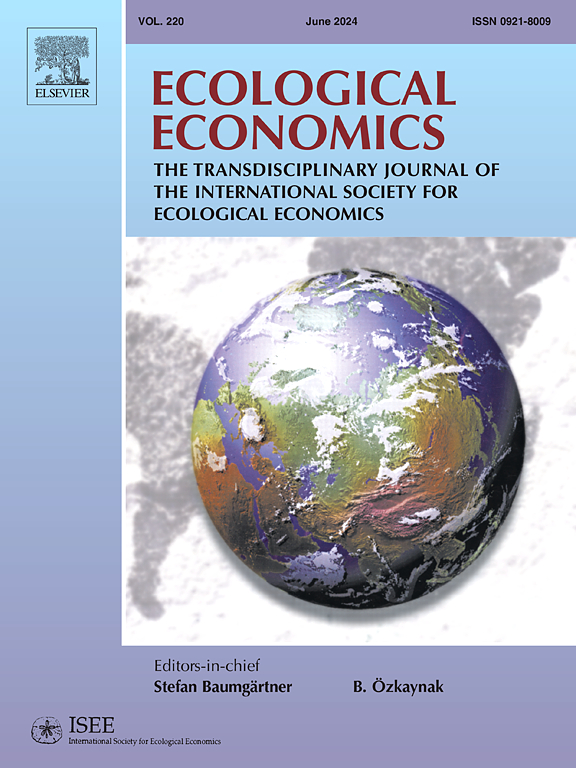全球贸易模式的变化加剧了全球的不平等 实现可持续发展目标
IF 6.6
2区 经济学
Q1 ECOLOGY
引用次数: 0
摘要
实现联合国可持续发展目标(SDGs)受到一个国家在全球价值链中的地位及其参与国际贸易程度的影响。在此,我们评估了 2004 年至 2014 年间全球贸易模式(CGTP)的变化如何影响 141 个国家/地区的 13 个可持续发展目标指标,这些国家/地区又被划分为四个收入组。贸易模式的特点是贸易的方向、构成和规模,表明一个经济体从何处进口何种类型(构成)和规模的商品或服务(方向)。我们发现,CGTP 从两个方面加剧了国家间的社会经济和环境不平等:1)对于高收入和中高收入国家,CGTP 导致明显恶化的指标数量从 8 个指标(2004-2007 年)减少到 1 个指标(2011-2014 年),但对于中低收入和低收入国家,则从 5 个指标增加到 14 个指标;2)对于低收入国家,CGTP 导致附加值与大多数自然资源消耗和环境污染指标耦合,而对于其他国家,CGTP 加强了脱钩或减少了耦合。研究结果表明,实现可持续发展目标的关键之一是通过实施影响进口和纵向供应链的政策干预措施来解决富国和穷国之间的不平等问题,从而将贸易模式转向穷国的环境经济脱钩。本文章由计算机程序翻译,如有差异,请以英文原文为准。
Changes in global trade patterns increase global inequality towards Sustainable Development Goals
Reaching the UN's sustainable development goals (SDGs) is influenced by a country's position in global value chains and its involvement in international trade. Here, we assess how changes in global trade patterns (CGTP) during 2004 and 2014 impacted 13 SDG indicators in 141 countries/regions which are further divided into four income groups. Trade pattern is characterized by the direction, composition, and magnitude of trade, indicating an economy imports what types (composition) and magnitudes of goods or services from where (direction). We find that CGTP aggravated socioeconomic and environmental inequality between countries in two ways: 1) the amount of indicators that significantly worsened due to CGTP decreased from 8 indicators (2004–2007) to 1 (2011–2014) for high-income and upper-middle-income countries, but increased from 5 to 14 for lower-middle-income and low-income countries; 2) CGTP led to a coupling of value added with most natural resource consumption and environmental pollution indicators for low-income countries, while they strengthened decoupling or reducing coupling for other countries. The findings imply one key to achieving SDGs is to address the inequality between rich and poor countries through implementing policy interventions that influence import and vertical supply chain thereby shifting the trade patterns towards environmental-economic decoupling in poor countries.
求助全文
通过发布文献求助,成功后即可免费获取论文全文。
去求助
来源期刊

Ecological Economics
环境科学-环境科学
CiteScore
12.00
自引率
5.70%
发文量
313
审稿时长
6 months
期刊介绍:
Ecological Economics is concerned with extending and integrating the understanding of the interfaces and interplay between "nature''s household" (ecosystems) and "humanity''s household" (the economy). Ecological economics is an interdisciplinary field defined by a set of concrete problems or challenges related to governing economic activity in a way that promotes human well-being, sustainability, and justice. The journal thus emphasizes critical work that draws on and integrates elements of ecological science, economics, and the analysis of values, behaviors, cultural practices, institutional structures, and societal dynamics. The journal is transdisciplinary in spirit and methodologically open, drawing on the insights offered by a variety of intellectual traditions, and appealing to a diverse readership.
Specific research areas covered include: valuation of natural resources, sustainable agriculture and development, ecologically integrated technology, integrated ecologic-economic modelling at scales from local to regional to global, implications of thermodynamics for economics and ecology, renewable resource management and conservation, critical assessments of the basic assumptions underlying current economic and ecological paradigms and the implications of alternative assumptions, economic and ecological consequences of genetically engineered organisms, and gene pool inventory and management, alternative principles for valuing natural wealth, integrating natural resources and environmental services into national income and wealth accounts, methods of implementing efficient environmental policies, case studies of economic-ecologic conflict or harmony, etc. New issues in this area are rapidly emerging and will find a ready forum in Ecological Economics.
 求助内容:
求助内容: 应助结果提醒方式:
应助结果提醒方式:


